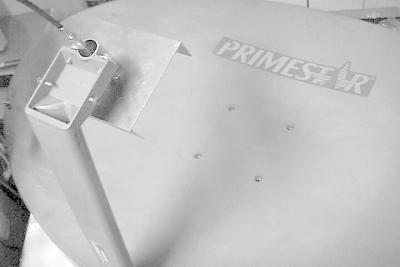BiQuad Feed for Primestar Dish
Make an even higher gain antenna out of a recycled Primestar dish.
The Primestar dishes are high-gain, low-cost, parabolic reflectors with an offset feed. They have superior sidelobe performance when compared with a wire grid antenna, reducing the chance that somebody off of the axis of your link will be able to interfere with it.
Additionally, the spacing between the feed slot and the feed mounting bar is small. It is about 55 mm, which is less than a half wavelength at 2.4 GHz. Failure to couple efficiently to the dish’s wide aperture or to minimize radiation into the mounting bar results in poor gain and/or significant sidelobes.
The feed is oriented for vertical polarization in Figure 5-8. To make it horizontal, merely rotate the feed by 90 degrees. You will lose about 3 dB of gain when using the horizontal mode, as the biquad’s radiation pattern is a better match for the dish’s oblong shape when vertical polarization is used.

Figure 5-8. The biquad feed mounted on the dish.
Construction of the Biquad
I used Printed Circuit board scraps for the 110 × 110 mm reflector, but it will be just as effective if made out of sheet brass or copper. Aluminum can be used if soldering of the rigid coax is not required at the feed point.
The reflector’s “lips” are 30 mm high, and serve to reduce coupling into the mounting bar. Note that they are only required along ...
Get Wireless Hacks now with the O’Reilly learning platform.
O’Reilly members experience books, live events, courses curated by job role, and more from O’Reilly and nearly 200 top publishers.

